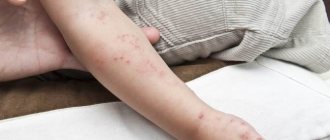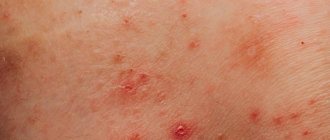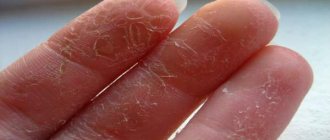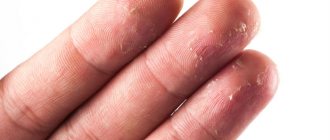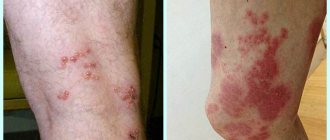A viral disease - herpes on the back and body, or shingles - develops under the influence of the herpes virus type 3, which also causes childhood chickenpox.
At the moment, medicine knows 8 varieties of the herpes virus, which have been studied to one degree or another.
Herpes type 3 is mainly localized in the back and ribs.
What herpes viruses cause back rash?
A rash on the back is caused by various diseases. To understand the nature of the rash, you need to be examined by a specialist.
Herpes is a contagious virus that can affect different parts of the body, including nerves and internal organs. The lips, eyes, and genitals are especially often affected, and the back is no exception.
Herpes viruses that cause back rash:
- Herpes of the third type. The second name is Varicella-Zoster virus. This type of virus is known as varicella or chickenpox. It also causes a disease called shingles.
- Cytomegalovirus. CMV infection is transmitted in utero, sexually and by airborne droplets. It usually appears during HIV infection, after chemotherapy.
- Herpes of the fourth type. The second name is Epstein-Barr virus. The disease is latent and difficult to diagnose.
- Herpes type six. A common childhood disease, often called roseola or pseudorubella. The rash is scattered all over the body, including the back.
Herpes is highly contagious and is found in urine, tears, semen, and saliva. Once it has penetrated the body, it never goes away, but remains forever “sleeping” in the body of its owner, becoming more active when the immune system is weakened.
Cytomegalovirus was discovered in 1956; it is still little studied and is the subject of debate. It affects about 50% of people.
Causes
The root cause of herpes on the back is a virus in the body. It may not manifest itself for a long time if a person has a strong enough immune system. But there are a number of diseases and conditions that provoke the pathological process.
Reasons that can cause the development of herpes on the back:
- Infection. The rash appears after contact with a carrier of the virus. It’s easy to get infected – just touch the towel of a sick person.
- Medical manipulations. If sanitation standards are violated in a hospital/clinic, the patient may become infected, for example, with a non-sterile instrument.
- Decreased immunity. Any cold can trigger the activation of the virus. Most often, the virus appears on the lips, but can occur anywhere else.
- Frequent stress. With nervous overload, any pathology can develop. Being nervous and worried, a person causes damage to his body.
Symptoms and course of the disease
Herpes on the back is often called lumbar or herpes zoster. It occurs mainly in people over 45 years of age who have once had chickenpox. Main symptoms of the disease:
- at the site of future rashes, a person feels itching, burning and discomfort;
- then these areas turn red, visible swelling occurs;
- possible increase in body temperature;
- a skin rash appears;
- in the area of inflammation, the lymph nodes are enlarged.
A rash with shingles can appear not only on the back, but also in the lower back, chest, abdomen, neck and even face. These are small pimples filled with a cloudy liquid, which, when large, merge into a single spot.
First, itching and burning appear at the site of future rashes; after 3-4 days, vesicles with liquid contents form. If you do not touch them, then by 6-7 days they will dry out and become crusty. After the crust falls off, and this happens on days 3-5, the person is at the stage of recovery.
Many doctors claim that it is not necessary to treat herpes on the back, the main thing is not to scratch the itchy areas. Otherwise, the virus will spread further, and the damaged wounds will become infected. The average duration of the inflammatory process is 10-21 days.
Features of herpes on the back
Herpetic infections occur differently in patients of different categories. Herpes is especially dangerous for children and pregnant women.
In children
Herpes in children is more severe than in adults, as they do not tolerate pain, itching and fever well. Their immunity is not fully developed to fight the virus, so the disease often leads to complications.
Not all antiviral drugs are approved for use in the treatment of children, so self-medication is unacceptable.
During pregnancy
Herpes is dangerous for both the pregnant woman and the fetus. Infection of the latter occurs in utero or during childbirth. The virus in this case is dangerous not only due to possible complications, but also due to fetal malformations.
During pregnancy, in addition to the rash and usual symptoms, additional signs may appear:
- nausea with vomiting;
- pain in the ears and eyes;
- convulsions;
- muscle weakness.
To treat pregnant women, the doctor selects medications that cannot harm the fetus.
Methods for diagnosing herpes on the back
Not every doctor is able to make an accurate diagnosis at a glance and determine the type of virus that caused the disease. Errors especially often occur due to accompanying symptoms - fever, headaches and internal pain.
The patient turns to a therapist, who makes a diagnosis, and if questions arise, refers him for additional examination. The patient is recommended to be examined by an infectious disease specialist, a dermatologist, and, if necessary, a neurologist.
Herpes is easy to differentiate from eczema and dermatitis by the specific type of rash. But if an external examination is not enough, laboratory diagnostics are used.
Laboratory research methods:
- scraping of erosions;
- virological examination of the contents of the vesicles;
- blood test to detect antibodies to the virus.
With herpes, an increased ESR is detected in the blood.
How the disease develops
Each disease that causes rashes on the back of the body has some characteristics depending on the virus.
Shingles
- can occur in both adults and children (albeit extremely rarely);
- is a consequence of previous chickenpox (chickenpox) and the most common cause of the development of herpes on the back;
- if such a patient comes into contact with children, children can get chickenpox;
- the rashes follow the course of the nerves, most often intercostal, as shown in the figure and photo:
Reminds:
- contact dermatitis (photodermatitis, after insect bites);
- cystic dermatosis (pemphigus, dermatitis herpetiformis).
The disease is dangerous in terms of complications - they “hit” the nervous system, causing:
- paralysis;
- sensitivity disorders;
- movement disorders.
In the ear form, the rash follows the course of the nerves on the face, and the result can be inflammation of the auditory nerve and facial paralysis. The latter is dangerous due to a serious cosmetic defect - the face may “skew” to the affected side, because the facial muscles will stop responding to the commands of the brain and freeze in a forced position.
Pseudorubella
herpes on a child's back looks like a fine-grained rash;
- can cover the entire body;
- characterized by a severe form - temperature up to 40°C, difficult to overcome with conventional methods (taking Nurofen, paracetamol, ibuprofen);
- Fever can often turn into convulsions and be accompanied by loss of consciousness.
In appearance the disease resembles:
- measles;
- rubella;
- an allergic reaction to the medicine (urticaria-type rash, increased body temperature, etc.).
Without modern diagnostic methods, it is difficult to distinguish pseudorubella from the above conditions, which can be fatal to a child - for example, measles can result in pneumonia - therefore, if an extensive rash appears on the baby’s body, you should immediately contact a specialist. Only a doctor can make an accurate diagnosis and select appropriate treatment. The use of folk remedies in this case is unacceptable!
Infectious mononucleosis
- symptoms are more often found in children 1-5 years old;
- triad – fever, adenopathy, tonsillitis;
- sudden onset of illness, increased body temperature;
- damage, enlarged lymph nodes;
- damage to the palatine tonsils is similar to streptococcal tonsillitis and diphtheria of the pharynx - weakness, sore throat, enlargement of the tonsils and the appearance of plaque on them, damage to the lymph nodes are also observed;
- rashes, the so-called polymorphic exanthema;
- yellowness of the skin, sclera of the eyes;
- darkening of urine and lightening of feces is also one of the manifestations of jaundice associated with damage to liver tissue;
- development of conjunctivitis.
An atypical course of the disease cannot be ruled out - instead of the above signs of the disease, something else comes first.
It is impossible to say for sure how to treat infectious mononucleosis - each case must be considered separately, depending on the patient’s age and condition.
Cytomegalovirus infection
At-risk groups:
- children under 3 years old;
- pregnant women;
- persons with immunodeficiency - HIV, cancer patients using chemotherapy and cytostatics;
- persons during the period of onset and activity of sexual activity.
Peculiarities:
- may be asymptomatic;
- damage to the skin and mucous membranes in the form of a rash can occur even in absolutely healthy individuals, while manifestations of the disease on other organs and systems are typical only for a weakened organism;
- Complications are rare, but timely treatment is necessary to avoid them.
Treatment
Herpes in most cases, especially if diagnosed on time, does not require hospitalization. The patient is recommended complex treatment.
Drugs
For herpes, systemic and local drugs are prescribed:
- Antiviral. The most popular drug is Acyclovir. These are tablets that are taken in weekly courses. Antiviral ointments are also prescribed - Viferon and Zovirax.
- Antihistamines. Relieves irritation and swelling, relieves itching. Patients are prescribed Cetrin, Zyrtec and other tablets. To enhance the effect, the rashes are lubricated with Fenistal.
- Antipyretic. Medicines containing paracetamol and ibuprofen help reduce the temperature. They are prescribed at a temperature of +38.5 °C and above.
- Painkillers. Pain syndrome is relieved with the help of Ketonal, Diclofenac, etc. For severe pain, a novocaine blockade is given.
- Antiseptics. Prescribed when erosion occurs. For example, hydrogen peroxide.
- Immunomodulatory. Vitamin and mineral complexes are recommended - Vitrum, Alphabet and others.
Traditional medicine methods
In folk medicine there are enough remedies to alleviate and improve the condition. But alone, without antiviral drugs, you won’t be able to cope with herpes.
Traditional recipes for herpes:
- Propolis ointment. Grind the propolis and fill it with alcohol (1:1). After 2 hours, place in a water bath and evaporate the alcohol. Mix propolis with pine resin, natural wax and animal fat (4:2:1:3). Apply the resulting ointment to the affected areas.
- Aloe leaves. Cut a large leaf lengthwise. Apply to affected skin. Take the fleshy leaves of old plants.
- Celandine juice. Rinse fresh leaves. When the water has drained, pass them through a meat grinder. Squeeze out the juice and place in a cool place. While the juice is fermenting, shake it and release the gases by opening the lid. Apply the product to the rashes.
- Honey, ash, garlic. Mix 150 g of honey with ash (1.5 tbsp) and 4-5 cloves of garlic. Apply the prepared mixture to the herpetic rash 4 times a day.
- Honey and apple cider vinegar. Mix honey and vinegar (1 tbsp each). Lubricate the affected areas with the composition 3 times a day.
Other means
If a person has a type of herpes such as lumbar herpes, then it would be advisable to take the following folk remedies:
- Aloe. The juice and leaves of this plant help accelerate tissue regeneration and reduce inflammation. The leaves should be applied to the damaged area of the skin.
- Kalanchoe. A paste of fresh leaves or juice of this plant is also effective for lower back herpes. It is used once every 2 hours as rubbing on diseased areas of the skin or as a kind of compress (the paste is placed on gauze and applied to damaged skin).
- A mixture of apple cider vinegar and honey in equal proportions is used to lubricate damaged skin.
- A mixture of carrot juice and apple (3:1) with the addition of a bunch of parsley and beet tops. Used internally. Take a glass a day until complete recovery.
- Fir essential oil. Apply to the damaged area twice a day.
- Camphor alcohol - lubricate damaged areas twice a day.
Spinal herpes can be treated with folk remedies only if all the rules for preparing and storing the remedies have been followed.
Prevention
The goal of prevention is to strengthen the immune system and improve overall health. For adults who did not have chickenpox (chickenpox) in childhood, it makes sense to get vaccinated to reduce/eliminate the risk of herpes.
Prevention measures:
- play sports;
- stop smoking and alcohol;
- eat well;
- take vitamin and mineral complexes;
- avoid stress;
- toughen up;
- normalize your work and rest schedule;
- Consult your doctor on time and follow his recommendations.
Possible complications
Herpetic rashes are just one of the symptoms of herpes viruses. Much more dangerous are the consequences that these pathogens can provoke.
Possible complications:
- With chickenpox, there is a risk of developing pneumonia and meningitis.
- When scratching a herpetic rash, infection can occur, after which scars remain on the body.
The appearance of a rash on the back is a serious signal that requires immediate attention. If it is caused by herpes, urgent antiviral treatment is necessary, as this infection often leads to life-threatening complications.
What is prohibited from smearing herpes?
If you have herpes on your body, it is strictly forbidden to use certain medications. Otherwise, the disease will only get worse. These medications include ointments and creams with hormones (Dexamethasone, Lokoid). They will relieve inflammation, but at the same time weaken the body’s protective functions. Herpes will drag on for a long time, and complications can affect the central nervous system.
Do not use alcohol tinctures, brilliant green, iodine and other compounds. Ointments containing ethanol will delay the healing process, and the pain will only intensify.
3.7 / 5 ( 6 votes)

